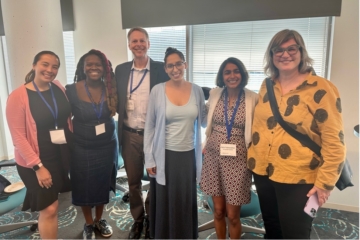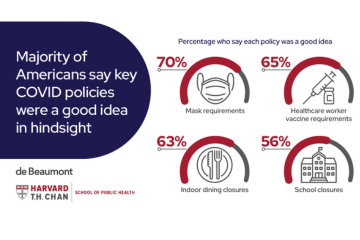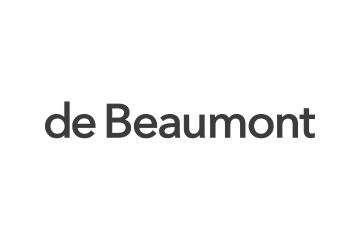
Photo credit: August de Richelieu
Data show the greatest influence on employee health comes from the social, economic, and environmental conditions in which people live — not genetics or personal choices. Community health is in many ways a prescription for thriving employees, resilient businesses, and economically vibrant communities. By focusing on community wellness, businesses can play a leading role in strengthening the nation’s health.
Campbell Soup Company is one of a growing number of companies that recognizes the role of community health in its strategy. Ten years ago, Campbell made a groundbreaking commitment of $10 million over 10 years with the launch of its “Healthy Communities” program designed to support the health of young people in Camden, New Jersey (where their headquarters have been located since 1869). With a specific aim to help reduce childhood obesity and address food insecurity, Campbell applied a systems approach to address this long-standing issue. They brought together community members and partners from across sectors to design an approach that looked at the structural issues related to food insecurity in the community.
Now, with the completion of the program, Stephen Massey from the Health Action Alliance sat down with Kim Fremont Fortunato, vice president for community affairs for Campbell Soup Company and president of the Campbell Soup Foundation, to learn more about the program, including what the business imperative was and what they learned. See below for excerpts from the town hall on “Strengthening Business Resiliency Through Public Health.” Watch the entire conversation.
The following has been edited for length and clarity.
Stephen: Are there any topline findings that you can share with us that help make the case for these types of long-term investments? How has this program really benefitted your people and your company’s bottom line?
Kim: First of all, the 10-year commitment is far greater than the $10 million. We leveraged more than dollar for dollar across the partners who were involved in this. We brought federal dollars, regional dollars, and private dollars, in addition to the Campbell commitment. But that 10-year long-term commitment was vital. Being part of this program became such a source of pride for so many, including a source of pride for our employees.
A small example of that was hosting six-week cooking courses for our third-grade students in our Campbell Consumer Test Kitchens — six kitchens, for about 20 students, and about 24 Campbell employee volunteers. This included our chefs, registered dietitians, and employees from cross-functional areas of the company. The You could see what great joy and a source of pride it was for employees to teach these kids how to cook and listen to the kids talk about their own experiences It manifested such great value for all involved and showed our commitment to the community and commitment to others that is part of Campbell DNA. To see it in action was terrific, and the kids loved being in the Consumer Test Kitchen.
Measuring the success of your company’s public health programs from Meteorite on Vimeo.
Stephen: Can you share some insights around how you landed on childhood obesity and hunger as the issue Campbell’s focused on?
Kim: In 2010, it was the beginning and height of Let’s Move [an initiative to address childhood obesity in America]. Our leadership team, including our executive chef, was invited to the White House as part of the campaign to end the epidemic of childhood obesity and a plan to pair chefs with schools to help teach kids healthy habits. You may remember the iconic photo of hundreds of chefs on the White House lawn. Our leadership team at that time had an ah-ha moment and said, we are going to create a signature, philanthropic program around childhood obesity and hunger. The team was also acutely aware of the issues that Camden, New Jersey, has faced for decades as a result of many structural issues. It was really the brainchild of the leadership team, and in large part thanks to what was happening with the Let’s Move movement, and the attention around nutrition, childhood obesity, and child wellness.
Moving from idea to action from Meteorite on Vimeo.
Stephen: How can others make the case that investments in community health, like the one you just described, is a sound business strategy? What messages do you think are most persuasive when making the case for these types of community health investments?
Kim: Campbell’s has 31 locations in North America. While the City of Camden, New Jersey may not be representative of all of our communities, many of our communities are manufacturing communities and our employees in those sites, both rural and urban sites, live in the communities. An investment in our community is an investment in our employees, their families, well-being, and their environment. So, for us it is not only the right thing to do, but the natural thing to do to invest in places where we live and work, and certainly invest in our people, which are our highest priority. We have been in Camden since four years after the end of the Civil War. It’s our home, we have been integral and a mainstay in that community for more than a century and a half. It is our home, it is our backyard, and it is critically important to us as a neighbor and a partner.
Stephen: What questions should someone consider if they are designing a program or intervention in their community?
Kim: It is a great question, and one that I asked myself around year seven of Healthy Communities. I wanted to build on our learnings, but also be very strategically aligned with the business. I really looked at shared value, and the creation of shared value – using business as a force for good, driving economic success and simultaneity driving impact on a social issue. And that is a question that I think that my business colleagues listening will find valuable to ask: Where can we drive both business outcomes as well as social outcomes? How do we build shared value using business as a force for good?
Our next iteration, 2.0, is called Full Futures and it is focused on creating school nutrition environments where children can thrive in school and in life. Why school nutrition? Campbell recognized the vital role schools play in providing daily nutrition to children, supporting their growth and development. We know that a well-nourished child is more likely to succeed in school and in life. We also have a food service team and an R&D team committed to providing good nutrition to our students. Working with our business partners, community partners and students, we will collaborate to drive shared value.
The program just launched in October of 2021, and a component of the program is an initiative we created with our R&D folks in our food service division and middle school and senior high school councils — youth advisory councils who we compensate for their time. They are working with our R&D team and food service teams to share what they like to eat in the middle school and high school cafeterias, what they don’t like to eat, what they want to see more of — so you can seed the opportunities to drive innovation for Campbell and drive impact in school nutrition for our students in Camden, and ultimately beyond. Simultaneously, we are affording the students the opportunity to build relationships with professionals in the food industry and explore the different career opportunities in that field.
Want to learn more about Campbell’s community work? Explore their community work on their website.




